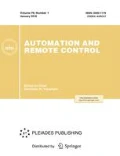Abstract
In this paper we introduce a modification of the concept of Equilibrium in Secure Strategies (EinSS), which takes into account the non-uniform attitudes of players to security in non-cooperative games. In particular, we examine an asymmetric attitude of players to mutual threats in the simplest case, when all players are strictly ordered by their relation to security. Namely, we assume that the players can be reindexed so that each player i in his behavior takes into account the threats posed by players j > i but ignores the threats of players j < i provided that these threats are effectively contained by some counterthreats. A corresponding equilibrium will be called a Chain EinSS. The conceptual meaning of this equilibrium is illustrated by two continuous games that have no pure Nash equilibrium or (conventional) EinSS. The Colonel Blotto two-player game (Borel 1953; Owen 1968) for two battlefields with different price always admits a Chain EinSS with intuitive interpretation. The product competition of many players on a segment (Eaton, Lipsey 1975; Shaked 1975) with the linear distribution of consumer preferences always admits a unique Chain EinSS solution (up to a permutation of players). Finally, we compare Chain EinSS with Stackelberg equilibrium.
Similar content being viewed by others
References
Aleskerov, F.T., Game-Theoretic Modeling: An Attempt of Brief Discussion and a Forecast of Development, Zh. Novoi Ekonom. Assots., 2013, vol. 17, no. 1, pp. 181–184.
Iskakov, M.B, Equilibrium in Safe Strategies, Autom. Remote Control, 2005, vol. 66, no. 3, pp. 465–478.
Iskakov, M.B. and Iskakov, A.B, Equilibium Contained by Counter-Threats and Complex Equilibrium in Secure Strategies, Autom. Remote Control, 2016, vol. 77, no. 3, pp. 495–509.
Iskakov, M.B. and Iskakov, A.B, Equilibria in Secure Strategies in the Bertrand–Edgeworth Duopoly, Autom. Remote Control, 2016, vol. 77, no. 12, pp. 2239–2248.
d’Aspremont, C. and Gerard-Varet, L.-A., Stackelberg-Solvable Games and Pre-Play Communication, J. Econom. Theory, 1980, vol. 23(2), pp. 201–217.
Baye, M.R., Kovenock, D., and de Vries, C.G, The Solution of the Tullock Rent-Seeking Game When R > 2: Mixed-Strategy Equilibria and Mean Dissipation Rates, Discussion Paper 1993-68, Tilburg University, Center for Economic Research, 1993.
Borel, E, The Theory of Play and Integral Equations with Skew Symmetric Kernels, Econometrica, 1953, vol. 21(1), pp. 97–100.
Dasgupta, P. and Maskin, E, The Existence of Equilibrium in Discontinuous Economic Games. II. Applications, Rev. Econom. Stud., 1986, vol. LIII, pp. 27–41.
Eaton, C. and Lipsey, R, The Principle of Minimum Differentiation Reconsidered: Some New Developments in the Theory of Spatial Competition, Rev. Econom. Stud., 1975, vol. 42, pp. 27–50.
Iskakov, M., Iskakov, A., and Zakharov, A, Equilibria in Secure Strategies in the Tullock Contest, CORE Discussion Paper 2014/10, Louvain-la-Neuve: Université Catholique de Louvain, Center for Operations Research and Econometrics, 2014.
Iskakov, M. and Iskakov, A., Equilibrium in Secure Strategies, CORE Discussion Paper 2012/61, Louvainla-Neuve: Université Catholique de Louvain, Center for Operations Research and Econometrics, 2012.
Iskakov, M. and Iskakov, A, Solution of the Hotelling’s Game in Secure Strategies, Econom. Lett., 2012, vol. 117, pp. 115–118.
Iskakov, M. and Iskakov, A., Asymmetric Equilibria in Secure Strategies, Working Paper WP7/2015/03, National Research University Higher School of Economics, Moscow: Higher School of Economics Publ. House, 2015.
Kats, A. and Thisse, J.-F., Unilaterally Competitive Games, Int. J. Game Theory, 1992, vol. 21, pp. 291–299.
Osborne, M.J. and Pitchik, C, Equilibrium in Hotelling’s Model of Spatial Competition, Econometrica, 1987, vol. 55(4), pp. 911–922.
Owen, G., Game Theory, New York: Academic, 1968.
Rothschild, M. and Stiglitz, J.E, Equilibrium in Competitive Insurance Markets: An Essay on the Economics of Imperfect Information, Quart. J. Econom., 1976, vol. 90, pp. 629–649.
Shaked, A., Non-Existence of Equilibrium for the 2-Dimensional 3-Firms Location Problem, Rev. Econom. Stud., 1975, vol. 42, pp. 51–56.
Stackelberg, H., Marktform und Gleichgewicht, Wien: Springer, 1934.
Wilson, C, A Model of Insurance Markets with Incomplete Information, J. Econom. Theory, 1977, vol. 16, pp. 167–207.
Author information
Authors and Affiliations
Corresponding author
Additional information
Original Russian Text © A.B. Iskakov, M.B. Iskakov, 2016, published in Matematicheskaya Teoriya Igr i Ee Prilozheniya, 2016, No. 1, pp. 80–105.
Rights and permissions
About this article
Cite this article
Iskakov, A.B., Iskakov, M.B. Chain equilibria in secure strategies. Autom Remote Control 78, 1159–1172 (2017). https://doi.org/10.1134/S0005117917060169
Received:
Published:
Issue Date:
DOI: https://doi.org/10.1134/S0005117917060169



